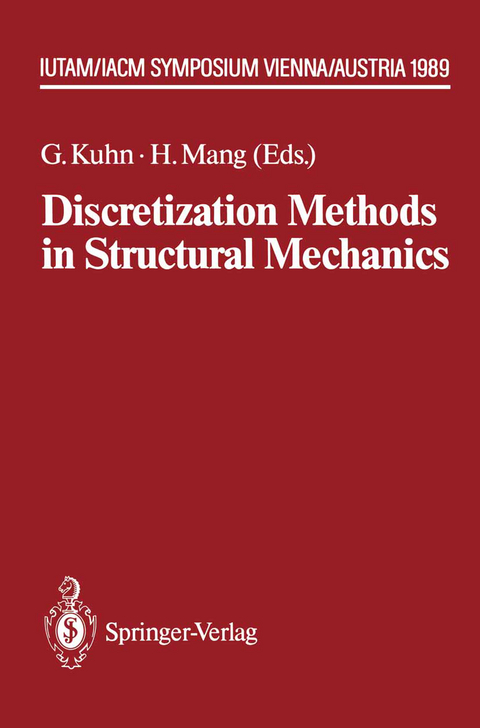
Discretization Methods in Structural Mechanics
Springer Berlin (Verlag)
978-3-642-49375-1 (ISBN)
Error Estimators and Mesh Adaptation for Thin-Walled Structures at Finite Rotations.- Treatment of Domain Integrals by Using the Dual and Multiple Reciprocity Methods.- BIE Solutions for Applied Thermoplasticity by Collocation.- State Characterization in Sampling Points and Representation of Velocity Fields by Nodal Values as a Basis for Discretization.- The Method of Consecutively Embedded Finite-Element Models.- Locally Blending Interpolation Technique in Finite Element Mesh Refinements and Improved Stress Analysis.- Nonconforming Finite Elements Based on the Free Formulation.- Assumed Strain Elements with Optimal Interpolation.- Linear and Nonlinear Transient Problems of Thermomechanics by BEM.- Dynamic Interaction Analysis in Wave Propagation Problems by a Time-Dependent Boundary Element Method.- Co-Rotational Beam Elements for Two- and Three-Dimensional Non-Linear Analysis.- A High-Precision Adaptive Procedure for Solving Kirchhoff Plates.- Natural Finite Differences in Shell Modelling for Impact Analysis.- Discretization and Solution Techniques for Liquid Filled Shells of Revolution under Dynamic Loading.- Novel Computational Strategies for Solution of Large-Scale Structural Problems.- Consistent Formulation of Shear Constrained Reissner-Mindlin Plate Elements.- A Nonlinear Shell Theory with Through-The-Thickness Stretch.- On Symmetrization in Boundary Element Elastic and Elastic-Plastic Analysis.- A Variational Formulation of the BEM for Elastic-Plastic Analysis.- Discretized Strategies for the Investigation of Instability Problems in Structural Mechanics.- On Static and Dynamic Instability Analysis of Thin- Walled Structures.- Probabilistic Finite Element Analysis of Unsymmetrical Buckling of Thin Shallow Spherical Shells.- A Combined Analytical and Finite Element Method for Non-Collinear Crack Growth in Brittle Solids.- Numerical Simulation of Crack Propagation in Shells.- Discretization Considerations with Hypersingular Integral Formulas for Crack Problems.- FRANSYS: A Software System for the Simulation of Crack Propagation in Three Dimensions.- Design Sensitivity Coefficients for Linear Elasticity Problems by the Derivative Boundary Element Method.- The Panel Clustering Method for BEM.- Exact Finite Elements for the Linear Buckling Analysis of Unidimensional Structural Problems.- Coupled Numeric-Symbolic Computations in Structural Mechanics.- The Implementation of Finite Element Computations in Transputer Based Systems.- A BEM-Formulation of Nonlinear Plate Vibrations.- A Unified Approach to the FE and Generalized Variational FD Methods in Nonlinear Mechanics, Concepts and Numerical Approach.- Stress Analysis of Laminated Composites by Hybrid Finite Elements.- Liquid Loaded Membranes under Large Deformations.- Stabilizing and Destabilizing Effects of Small Damping for Structures with Finite Number of Degrees of Freedom.- Treatment of Micro-Mechanical Phenomena by Finite Elements.- On the Coupling of Finite Elements and Boundary Elements.- Three-dimensional Coupling of FEM and DEM in Elasticity.- Coupling of FE- and BE-Discretizations for 3D-Stress Analysis of Tunnels in Layered Anisotropic Rock.
| Erscheint lt. Verlag | 5.6.2012 |
|---|---|
| Reihe/Serie | IUTAM Symposia |
| Zusatzinfo | XXVIII, 436 p. 194 illus. |
| Verlagsort | Berlin |
| Sprache | englisch |
| Maße | 155 x 235 mm |
| Gewicht | 702 g |
| Themenwelt | Naturwissenschaften ► Physik / Astronomie ► Mechanik |
| Technik ► Bauwesen | |
| Schlagworte | Boundary element method • Dikretisationsmethoden • Festkörpermechanik • finite Elementemethode • Finite Element Method • Mechanics • Randelementmethode • Randelementmethode / Boundary-Elemente • solid • Structural Mechanics • Strukturmechanik |
| ISBN-10 | 3-642-49375-0 / 3642493750 |
| ISBN-13 | 978-3-642-49375-1 / 9783642493751 |
| Zustand | Neuware |
| Haben Sie eine Frage zum Produkt? |
aus dem Bereich


